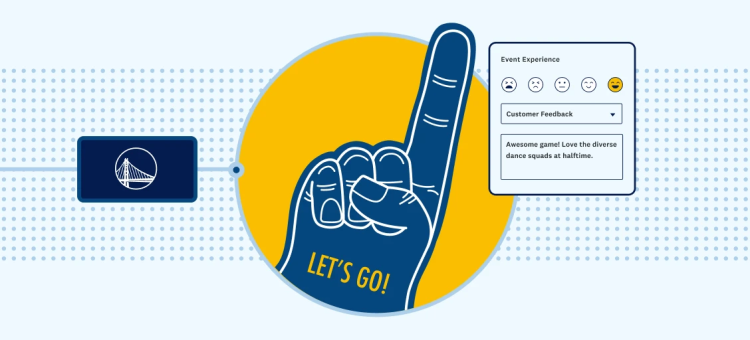This is a guest post from one of our SurveyMonkey Technology Ecosystem Program (STEP) partners, Rybbon. The author is Kristy Hartman, Marketing Manager.
Prior to Covid-19 sweeping the globe, office workers went to the office, teachers to their classrooms, and customer service reps to the call center. Almost instantly, everyday life and traditional work environments changed into what could be considered our “new norm.”
A year into the pandemic, while some workers are beginning to return to the office, others are continuing to work remotely. The hybrid workforce is gaining momentum and with it, challenges and opportunities that are causing business leaders to rethink many of their strategies, including how they can keep remote employees engaged.
Turn hybrid workforce challenges into opportunities:
As more businesses give workers the option to work from the office or remotely, there are challenges that must be overcome, such as keeping workers engaged regardless of their physical location. We’ve highlighted the top engagement opportunities that the hybrid workforce model presents.
Communication transparency:
To avoid team silos and possible knowledge gaps, you need to keep the lines of communication open across your hybrid workforce. This is where technology such as video conferencing is essential. Employees, whether they are participating face-to-face or remotely need to be active contributors to discussions, information sharing, and decision making.
Perceived productivity:
Onsite workers may believe their remote counterparts aren’t pulling their weight. From a management perspective, “remote workers may end up getting lower performance evaluations, smaller raises, and fewer promotions than their colleagues in the office,” according to research by MIT. To avoid unintentional bias, you need tools and structures that will ensure equality among all workers.
Working relationships:
Good working relationships between colleagues and with management are essential for worker engagement and productivity. Prior to remote working, water cooler conversations, team lunches, and after-work events enabled employees to connect with colleagues and build the comradery and relationships that create trust between and among co-workers. While off-sites may be off your radar, at least for now, you can bring your hybrid workforce together for team-building activities such as virtual games and competitions.
Onboarding and churn:
The inherent complexity of a hybrid workforce is acquiring and retaining employees. It all starts with the onboarding experience. Did you know that 20% of staff turnover typically occurs within the first 45 days of employment? And, nearly 33% of new hires are scouting for a new job within the first 6 months? While taking new hires on a tour of the office, providing in-person introductions, and conducting on-premises training may not be feasible with a hybrid workforce, you can still provide an onboarding experience that will engage employees from their very first day. Draw the new hire into the fold by appointing a mentor that can assist with work-related questions, as well as help them make social connections.
Is the hybrid workforce here to stay? A study conducted by Upwork found that by 2025, 36.2 million Americans will be working remotely—a whopping 87% increase from pre-pandemic days. As we continue to embrace our new ‘normal’, it’ll be important that you don’t lose sight of keeping hybrid workers engaged. Two of the best ways to accomplish this are by 1) using rewards and 2) keeping your finger on the pulse of your employees with periodic surveys.
Using digital rewards to keep hybrid workers engaged:
Everyone loves a reward, and your hybrid workforce is no different. Why not tie rewards to your engagement goals? Let’s revisit each of the engagement opportunities listed above to see how rewards can take your engagement strategies to the next level.
● Communication transparency: You need to stay connected with your teams and your team members need to stay connected with each other. Why not reward team members that take it upon themselves to organize meetings or take a lead role during meetings? Alternatively, use rewards as an appreciation gift when a hybrid worker comes up with a solution that solves a pressing problem.
● Perceived productivity: Promote and acknowledge hybrid workers’ outstanding contributions with quarterly digital rewards. For example, let’s assume your marketing department’s objectives are to:
-Increase collaboration with sales
- Gain a deeper understanding of customer needs
-Generate higher-quality leads
-Grow and maintain thought leadership.
Let the entire marketing team vote and announce the winner of each category during your department’s quarterly all-hands meetings.
● Working relationships: Get your team together for a virtual lunch that they purchase with digital gift cards from DoorDash or GrubHub. Or, turn your next video conference into a coffee and donut meeting by gifting your hybrid staff with a gift card from Dunkin Donuts or Krispy Kreme. Make virtual off-site team-building activities even more engaging by gifting the winner of virtual games or competitions with a Nike or Target digital gift card.
● Onboarding and churn: Don’t let a hybrid worker’s first day go unnoticed. Create a memorable experience for them with a gift card that will get them started on the right foot. Send them a Staples digital gift card which they can use to help cover their home office expenses.
These are just a few ways you can use digital rewards to help boost the engagement of your hybrid workforce. From service milestones and holiday gifts to bonuses and birthday celebrations, digital gift cards can be used for nearly any occasion. With immediate delivery, you can personalize your reward email with your company’s logo, messaging, and imagery, making your thank you an engaging experience.
Maximize the hybrid experience with employee surveys Know what makes your hybrid workforce tick with quarterly surveys that help you keep your finger on the pulse of your engagement strategies. Ask for direct and honest feedback with anonymous surveys or get their thoughts on how you can better engage with them. Since surveys aren’t a one-and-done initiative, be sure to check in regularly with follow-up surveys to see if your efforts are improving the hybrid working experience. If you're concerned about receiving feedback, don’t be. Give your survey response rates a boost by enticing respondents with a digital gift card.
By implementing these 4 engagement tips, you’ll be on your way to keeping your employees engaged—regardless of their location—over the long run.



